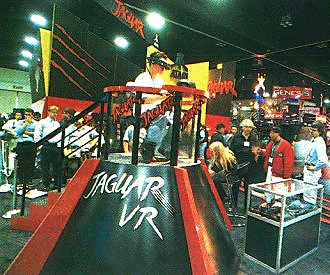|

The VR project was never to see the light of
day. Virtuality Inc. were the company Atari hooked up with to produce an ambitious
plan for a home VR headset at under $300.00. The unit was in development for over 2
years, and as Jaguar sales diminished, the VR unit was shelved.

Prototypes shown at the CES were actually
running from a Virtuality PC system under the show-booth! One game had been
programmed with VR capabilities, and that was Missile Command 2000.

The lightweight headset was
fully adjustable and was padded inside for maximum comfort. Inside
the unit, a 7" colour TFT LCD screen provided the players view, with a
resolution of 260 by 400 pixels. A built-in microphone allowed
players to communicate for planned networked gaming, and sound was
provided through the headset via stereo speakers.
A custom optical system
projected a binocular image to both eyes; which is aligned at infinity,
so focus adjustment was not needed. Two degrees of freedom
(left/right and up/down) were available and a field of view of 52
degrees horizontal by 40 degrees vertical.
The tracking station senses the position of the controller and the
headset via an infra-red tracking system (called "V-Trak" by Virtuality
Inc). The Jaguar VR tracking speed is 250Hz, with a lag time
faster than Virtuality's own arcade hardware of the time! The
tracker has a range of approximately 100 degrees and multiple trackers
can be daisy-chained together to provide a full 360° tracking area if
required.

|